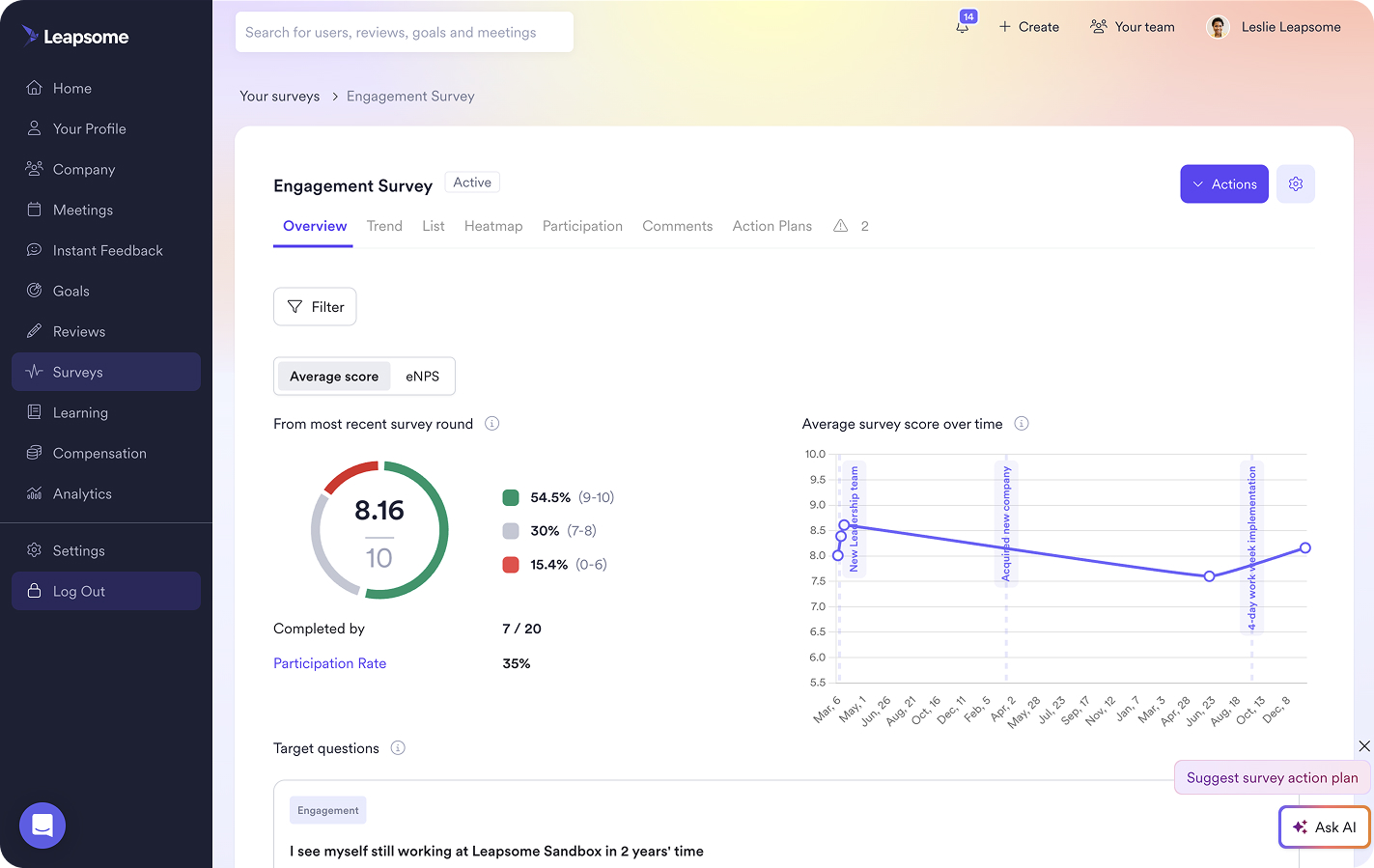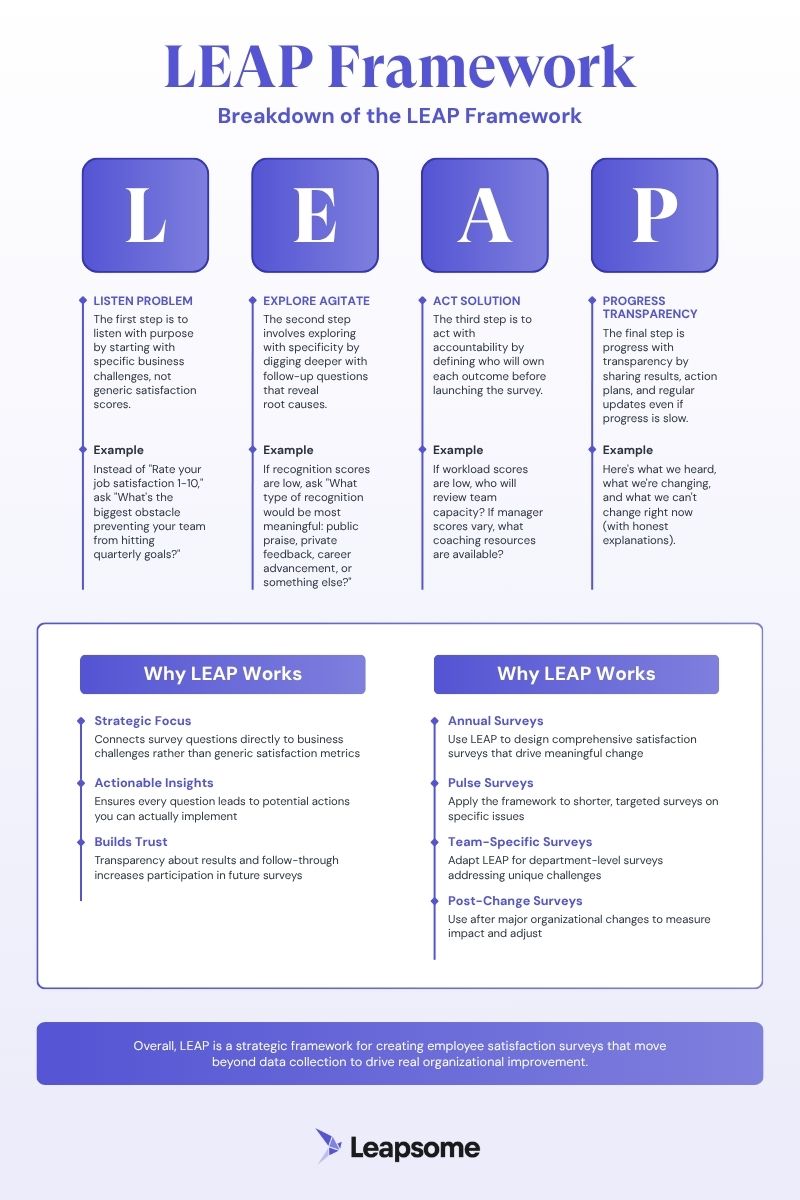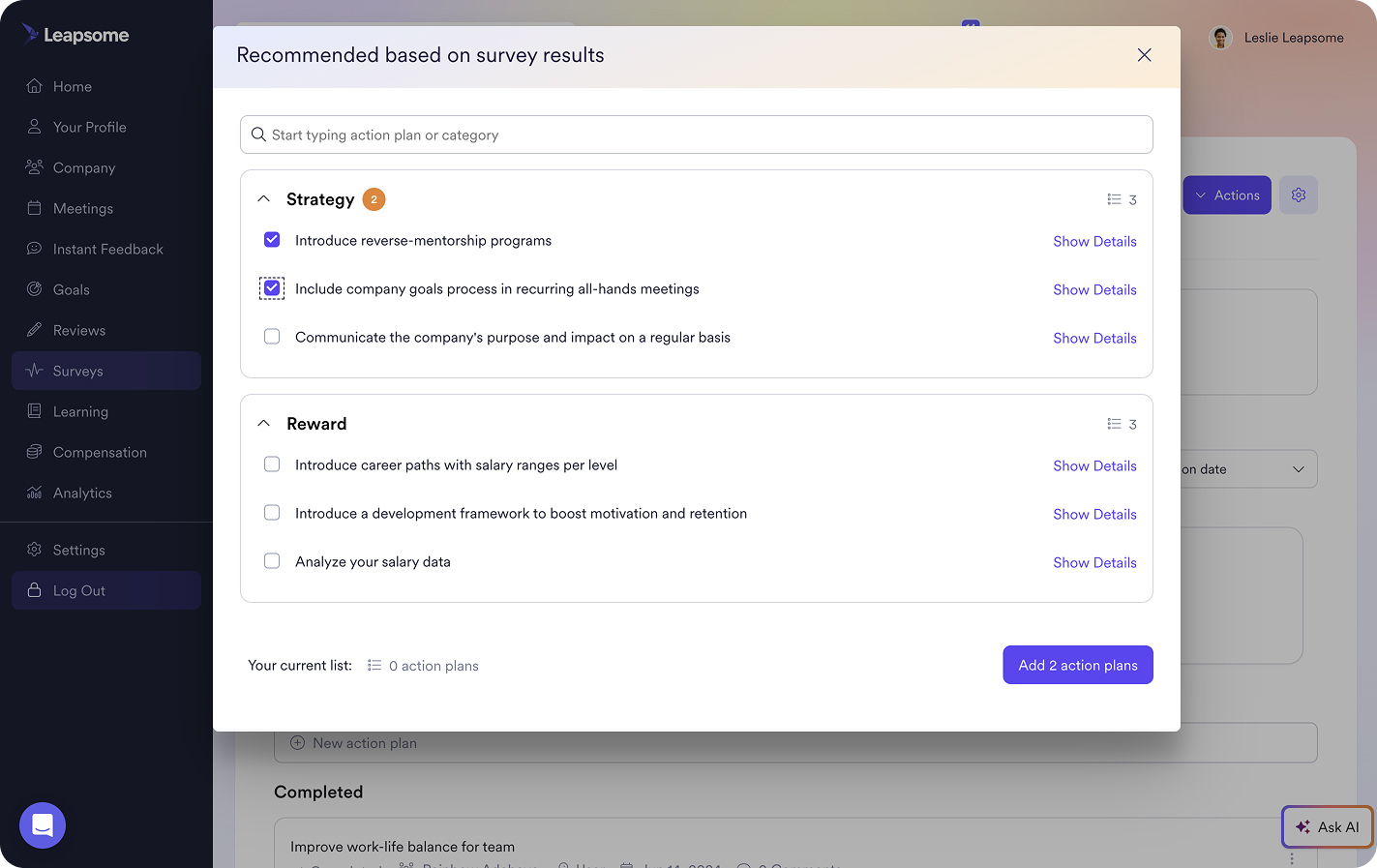50 employee satisfaction survey questions for effective team insights

You ask generic questions, get predictable results, and struggle to turn data into action. Meanwhile, satisfaction scores stay flat and retention problems persist.
Most organizations struggle with strategy, not effort. Effective satisfaction surveys require specific questions tied to real business challenges, clear plans for acting on feedback, and tools that help you track progress over time.
The 50 employee satisfaction survey questions below are organized by the themes that matter most for scaling tech companies. Each section includes guidance on what these questions reveal and how to act on different response patterns. Use them to build surveys that actually drive meaningful change.
Marie Hulk, our Senior People Enablement Manager at Leapsome, emphasizes the importance of strategic survey design: "Really ask yourself the “why”... like why am I sending this survey? what do I want to achieve with that survey and also connect the survey to your company strategy."
50 employee satisfaction survey questions, organized by theme
The right questions can reveal blind spots that generic "Are you satisfied?" surveys miss entirely, especially when global job satisfaction dropped to 62% in 2025 despite 82% saying their work is meaningful, with the average employee satisfaction rate in the U.S. sitting at approximately 50% as of July 2025.
Before you design your next survey, ask yourself this: if 60% of your engineering team rates "recognition" as a 3 out of 10, do you know what specific changes you'd make? If you don't have a clear answer, you're not ready to ask the question.
The questions below are organized by the themes that matter most for scaling tech companies. Each category includes a brief explanation of what these questions reveal and why they're worth asking - but only if you're prepared to act on the responses.

Company culture
Culture questions help you understand whether your values show up in daily work experience, not just on the office walls. Strong workplace relationships drive retention — 57% of people believe that having a good friend at work makes their job more enjoyable, and workers with many friends are nearly three times more likely to say they love their company.
- "I understand how my work contributes to our company's mission"
- "Our company values are reflected in how decisions are made"
- "I feel proud to work for this organization"
- "Our leadership team demonstrates the behaviors they expect from others"
- "I would recommend this company as a great place to work"
- "When mistakes happen, we focus on learning rather than blame"
- "I trust that leadership makes decisions in the best interest of employees"
- "Our company adapts well to change and new challenges"
What this reveals: If scores are low across the board, you likely have a leadership alignment issue. If they vary dramatically by team, look at which managers are best at translating company values into day-to-day work.
Job satisfaction survey questions
These questions dig into the daily experience of work itself - the tasks, responsibilities, and sense of purpose that drive long-term engagement.
- "I find my work meaningful and engaging"
- "I have the autonomy to make decisions about how I do my work"
- "My role makes good use of my skills and abilities"
- "I have access to the tools and resources I need to do my job well"
- "My workload is manageable and sustainable"
- "I understand what's expected of me in my role"
- "I'm able to maintain focus and avoid unnecessary interruptions"
- "My job allows me to learn new skills and grow professionally"
What this reveals: Low scores here often point to role clarity issues or resource gaps. In scaling companies, "I understand what's expected of me" frequently scores lowest as responsibilities shift rapidly.
Management and leadership
Your managers have an outsized impact on team engagement. These questions help you identify which leaders need support.
- "My manager provides clear direction and feedback"
- "I trust my manager to support my career development"
- "My manager recognizes good work when they see it"
- "I feel comfortable approaching my manager with problems or concerns"
- "My manager helps remove obstacles that prevent me from doing my best work"
- "Leadership communicates openly about company direction and changes"
- "I receive regular, helpful feedback about my performance"
- "My manager treats all team members fairly and with respect"
What this reveals: Segment these responses by manager to identify coaching opportunities. Teams with high management scores typically outperform on every other metric.
Compensation and benefits
Money matters significantly, with 55% of workers globally prioritizing salary as their most important job factor, though only 46% say they are satisfied with their job security.
- "I'm satisfied with my overall compensation package"
- "Our benefits meet my needs and those of my family"
- "I understand how my compensation is determined"
- "I feel my pay is fair compared to similar roles at other companies"
- "Our company offers competitive time-off policies"
- "I'm satisfied with our health and wellness benefits"
- "I understand the criteria for salary increases and bonuses"
What this reveals: If compensation scores are consistently low but you can't increase budgets immediately, focus on transparency about pay decisions and future increases.
Growth and development
In competitive talent markets, growth opportunities often matter more than current compensation.
- "I have opportunities to develop new skills in my current role"
- "I understand the potential career paths available to me here"
- "My manager and I regularly discuss my professional development"
- "I have access to learning and development resources"
- "I'm challenged by my work in a positive way"
- "I see a future for myself at this company"
- "Our company promotes from within when possible"
- "I receive mentoring or coaching that helps me grow"
What this reveals: Low development scores often correlate with higher turnover among top performers. Look for patterns by tenure - new hires vs. senior employees may have very different needs.
Work-life balance
Sustainable performance requires sustainable work practices, especially in demanding tech environments.
Work-life balance has become more complex with remote work debates. Leapsome's 2025 research shows that 56% of HR leaders face pressure to enforce return-to-office mandates, yet 81% say forced RTO isn't the most effective collaboration model. These questions help you understand your team's actual preferences rather than assumptions.

- "I'm able to maintain a healthy work-life balance"
- "I have flexibility in when and where I work"
- "I don't regularly feel burned out or overwhelmed"
- "Our company respects boundaries around after-hours communication"
- "I can take time off when I need it without feeling guilty"
- "My stress levels at work are manageable"
What this reveals: Watch for differences between individual contributors and managers - leadership often shows higher stress and lower balance scores.
Diversity, equity, inclusion and belonging (DEIB)
DEIB questions help you understand whether all employees feel valued and included, not just whether policies exist.
- "I feel like I belong and can be authentic at work"
- "People from all backgrounds have equal opportunities to succeed here"
- "I'm comfortable expressing different viewpoints in meetings"
- "Our company takes action to create an inclusive environment"
- "I see people like me in leadership positions"
What this reveals: Segment responses by demographics when possible. Significant gaps between groups indicate where focused inclusion efforts are needed most.
🪂 Don’t leave survey responses up in the air
Leapsome Surveys is AI-powered, making it simple to take action with result summaries and auto-generated action plan suggestions based on employee answers.
👉 Book a demo
The LEAP framework for building effective satisfaction surveys
Most employee survey failures happen before the first question is even written. Teams rush into survey design without a clear plan for what they'll do with the responses. Generic questions produce generic data that sits in a dashboard somewhere while nothing changes.
At Leapsome, we've developed the LEAP framework to help HR teams move beyond checkbox surveys toward meaningful organizational change. LEAP stands for Listen, Explore, Act, and Progress — four steps that ensure your satisfaction surveys drive real improvements.

L - Listen with purpose
Start with specific business challenges, not generic satisfaction scores. Instead of asking "Are you satisfied with your job?" ask questions that connect to real problems you're trying to solve.
Most survey failures happen before the first question is even written, particularly as only 37% of UK organizations conducted engagement surveys annually in 2022 — down from 79% in 2018.
Generic approach: "Rate your overall job satisfaction on a scale of 1-10"
Purpose-driven approach: "What's the biggest obstacle preventing your team from hitting its quarterly goals?"
Why this works: When we first started running our own satisfaction surveys, we made the classic mistake of asking broad satisfaction questions. The responses were interesting but didn't tell us what to actually fix. Once we shifted to asking about specific challenges — like "What slows down your work the most?" — we discovered concrete issues like tool friction and unclear handoffs that we could actually address.
E - Explore with specificity
Dig deeper with follow-up questions that reveal root causes. If someone rates recognition low, don't stop there. Find out what type of recognition would actually matter to them.
Generic approach: "I feel recognized for my contributions" (1-5 scale)
Specific approach: "What type of recognition would be most meaningful to you: public praise in team meetings, private feedback from your manager, career advancement opportunities, or something else?"
Why this works: Early on, our product team scored low on "feeling recognized." Instead of launching a company-wide recognition program, we dug deeper with follow-up questions. Turns out, engineers wanted technical mentorship and growth opportunities, while designers valued creative feedback and autonomy. One-size-fits-all recognition would have missed the mark entirely.
A - Act with accountability
Before launching any survey, define who will own each potential outcome and what changes are actually possible to implement. This prevents the classic mistake of asking questions you're not prepared to address.
Pre-survey planning:
- If workload scores are low, who will review team capacity?
- If manager scores vary widely, what coaching resources are available?
- If compensation concerns emerge, what's realistic to change in the next 12 months?
Why this works: We made the mistake of asking about compensation satisfaction before we had any budget flexibility to make changes. The feedback was valuable long-term, but in the short term it created frustration because people felt heard but not helped. Now we only ask questions when we have a realistic path to improvement, even if that timeline is 12-18 months out.
P - Progress with transparency
Share results, action plans, and updates regularly — even if progress is slow or some issues can't be fixed immediately. Transparency builds trust for future surveys.
Effective progress sharing includes:
- Key themes from the survey (not just scores)
- Specific changes that will be made (and timeline)
- Issues that can't be addressed immediately (and why)
- Regular updates on implementation progress
Why this works: Our first survey results sat in a shared folder that nobody looked at. Participation dropped significantly the next time around. Now our People team shares a brief update after every survey — what we heard, what we're changing, and what we can't change right now (with honest explanations). Survey participation has stayed consistently high because people see that their input leads to real changes.
LEAP in action
Here's how we used LEAP to solve a retention challenge on our own team:
Listen: Instead of asking generic satisfaction questions, we focused on why senior team members were considering other opportunities.
Explore: Follow-up conversations revealed that the issue wasn't compensation or workload — it was lack of clear career progression in a rapidly scaling company.
Act: We created transparent career frameworks and quarterly development conversations with clear accountabilities for managers.
Progress: We shared regular updates on framework development and tracked how many people were participating in development conversations.
The approach helped us retain key team members and gave us a blueprint for using our own platform more strategically. Surveys became a tool for solving specific business challenges rather than just collecting data.
”Employee satisfaction surveys help me as a people leader to understand how our team is feeling about their work, their leaders, and the company as a whole. This information is invaluable for us to drive decisions to make our team environment more positive, effective, and productive (which, ultimately, is what everyone wants).
It’s really common for companies to experience peaks and troughs in their performance, engagement, etc., but having a routine of surveying can help us stay on top of real-time sentiment and adapt our leadership and business communication to make sure employees feel listened to, increase their ownership, and feel empowered.”
— Lea Schmidt, Head of People and Talent at NeoTaste
Use Leapsome to run smarter satisfaction surveys
Most HR teams get stuck after collecting survey responses. You have data, but turning it into meaningful change feels overwhelming. Leapsome’s survey tool bridges that gap with tools that move you from insights to action.

PlusDental installs computer terminals in production facilities so every employee can participate in surveys. Their willingness to invest in hardware for survey participation signals that feedback genuinely matters.
Swapfiets runs surveys across 1,300 employees, including those without laptops, building survey access for non-laptop workers into their operations.
The goal is creating a feedback loop where survey insights drive targeted actions, which create measurable improvements, which build trust for more honest feedback in future surveys.
The path forward: From survey data to meaningful change
Employee satisfaction surveys only work when they lead to action. The 50 questions we've outlined give you a foundation, but the real impact happens in what you do next.
Your survey results will reveal patterns you didn't expect. Maybe your engineering team feels disconnected from company goals while your sales team struggles with workload balance. Maybe new hires are confused about career paths while senior employees want more autonomy. These insights are gold, but only if you act on them.
Start small. Pick the two or three themes that affect the most people or pose the biggest risk to your business. Create specific action plans with clear owners and timelines. Then communicate what you're doing and why. Your next survey will tell you whether those changes made a difference.
Remember that satisfaction is a lagging indicator, with academic research showing that satisfaction scores improve only after organizational changes are well underway.
The manager training you implement today might not show up in survey scores for six months. The career development framework you launch in Q2 might not impact retention until Q4. Stay consistent, measure progress, and trust the process.
The companies that get this right don't just run better surveys. They build cultures where people genuinely want to stay and grow. That's the real goal.
📦 Easily unpack your satisfaction results
Leapsome Surveys leverages powerful AI and analytics so you can summarize key themes quickly and sift through survey results faster with straightforward heat maps and bubble charts.
👉 Book a demo
Frequently asked questions about employee satisfaction surveys
What's the difference between employee satisfaction and employee engagement surveys?
Employee satisfaction measures what employees "get" from their work — compensation, benefits, work-life balance, and recognition. Employee engagement measures how connected and committed employees feel to their work and company mission. While related, satisfaction focuses on contentment while engagement focuses on emotional investment. Many organizations run both types of surveys to get a complete picture of their workforce. While related, satisfaction focuses on contentment while engagement focuses on emotional investment — which explains why only 21% of global employees are engaged at work, with 31% engagement in the U.S.
How often should you run employee satisfaction surveys?
Run comprehensive satisfaction surveys annually or bi-annually, with shorter pulse surveys monthly or quarterly. Annual surveys allow time for meaningful changes between cycles, while pulse surveys help you track progress on specific initiatives. Avoid over-surveying — quarterly comprehensive surveys often lead to survey fatigue and lower participation rates.
What's a good employee satisfaction survey response rate?
Aim for 70-80% participation in your satisfaction surveys, which aligns with the average response rate of 70–82% across industries depending on sector and organization size. Response rates below 60% may not represent your workforce accurately. To improve participation, keep surveys anonymous, explain how you'll use results, share previous survey outcomes and actions taken, and send gentle reminders without making participation mandatory.
How many questions should be in an employee satisfaction survey?
Keep annual satisfaction surveys to 15-20 questions maximum, with pulse surveys limited to 5-8 questions. Mix question types: use 60% closed-ended questions for benchmarking and trend tracking, and 40% open-ended questions for deeper insights. Every question should connect to a potential action you could take.
What are the most important employee satisfaction survey questions to ask?
Focus on key satisfaction drivers: compensation and benefits, manager effectiveness, work-life balance, career development opportunities, recognition and appreciation, company culture and belonging, role clarity and workload management. These areas have the strongest correlation with overall satisfaction and retention.
How do you analyze employee satisfaction survey results?
Start by segmenting data by team, tenure, role level, and location to identify patterns. Look for themes in open-ended responses and prioritize issues affecting the most people or posing the biggest business risk. Compare results to previous surveys to track progress. Focus on actionable insights rather than just satisfaction scores.
Ready to transform
your People operations?
Automate, connect, and simplify all HR processes across the employee lifecycle.
.webp)
.webp)
 Request a demo today
Request a demo today







.jpg)






















